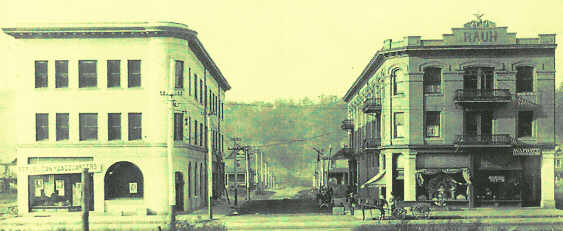|
On July 14, 1905, the North American firm invited more than 100 businessmen and professionals to cross the bridge, over which two tracks had been laid, and to visit the new town site. Fred B. Lawrence, superintendent of the firm, was in charge of the trip across the river, during which the visitors found Washington St. laid 70 feet wide for future heavy traffic and men already preparing a golf course, tennis courts and a baseball field west of the ravine. They also visited picturesque Laurel Hollow and its crystal spring, and traveled up to Virginia Terrace.
The building boom had drawn to the site brash construction men along with other temporary residents connected with the project. There were numerous colonies of Italians, Slavs and Austrians who had built various shelters, ranging form tents to mud and straw-thatched shacks, many along Grant St. and behind the new car barn of the streetcar line. Police were kept on alert to gambling and disturbances in the Kenilworth area where construction workers on the new locks resided.
Work on the streetcar line was nearing completion and work on the pottery had been started in the fall of 1904. For the streetcar line, a power plant was built, then the car barn and then a water reservoir on a hill above the town where a residential area, to be known as Newell Heights, was planned.
A filter crib was placed in the river during low water under the direction of Army engineers and was connected to pump station by a large suction main. A gas engine gave the pump station a capacity of a million gallons daily.
Fire hydrants also were installed.
In 1929, an 83-foot well was dug near the main office of the Laughlin plant to supplement the water supply of the town and industries, and in 1941, a similar porous concrete well was dug -- both of them 200 feet from the river bank.
Water form the 30-inch diameter wells is not derived from the river, but from natural drainage along rock strata from the hills, providing the town with clear water which needs only chlorination.
The old gas motor was replaced by three electric motors capable of pumping 2 1/2 million gallons daily, with three reservoirs and a standpipe for supply.
Keeping abreast with the needs of the community and its giant industrial potential, the Newell Co. today has under construction a sewage disposal plant at the mouth of Laurel Hollow. It is to be completed in the fall as part of the Ohio Valley river sanitation program. With the scheduled completion of interceptor sewers by next spring, the Newell plant may be the first in operation in this area.
During 1906 work was being pushed on the giant pottery, 600 feet long and 300 feet wide, designed to employ 1,200, with electric power and separate motors for each machine. And construction of homes also was being hurried. In June 1906 there were only a few isolated houses standing out in relief against the woods behind, but by December 1907 about 130 homes had been built, and the population of the town stood at 700.
 The brown brick Rauh Building had been constructed earlier and was headquarters for the North American firm, but with the completion of the white brick fire-proof Aaron Building in 1907, the firm moved into the new structure across 5th Street.[1]
The year 1907 marked the real birth of the town in many ways. Besides the organization of the volunteer firemen that year, the Presbyterian Church was organized in October and given recognition by the Wheeling Presbytery in December 1907. The Rev. E. B. Townsend was pastor for the group, which worshipped in the school rooms in the Aaron Building. The brown brick Rauh Building had been constructed earlier and was headquarters for the North American firm, but with the completion of the white brick fire-proof Aaron Building in 1907, the firm moved into the new structure across 5th Street.[1]
The year 1907 marked the real birth of the town in many ways. Besides the organization of the volunteer firemen that year, the Presbyterian Church was organized in October and given recognition by the Wheeling Presbytery in December 1907. The Rev. E. B. Townsend was pastor for the group, which worshipped in the school rooms in the Aaron Building.
1 The Aaron building has since been razed.
|